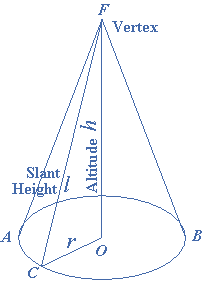Introduction to the Cone
A cone is a solid figure generated by a line, one end of which is fixed and the other end describes a closed curve in a plane.
A circular cone is a solid figure whose base is a circle and whose lateral surface area (i.e. curved surface area) tapers uniformly to a point which is called the vertex or apex. The axis of the cone is a straight line drawn from the vertex to the center of the base.

A right circular cone is a cone whose base is a circle and whose axis is perpendicular to the base. Such a cone can also be described as a solid formed by a right triangle rotated about one of its sides as an axis. It may, therefore, be called a cone of revolution. The altitude of a cone is the perpendicular line from the vertex to the base ($$OF$$ as shown in the figure).
The slant height is the length of a straight line drawn from the vertex to the circumference of the base ($$CF$$ as shown in the figure). If $$C$$ is any point on the circle (the base of the cone), we obtain the following using the Pythagorean Theorem,
\[\begin{gathered} C{F^2} = O{C^2} + O{F^2} \\ CF = \sqrt {{r^2} + {h^2}} \\ l = \sqrt {{r^2} + {h^2}} \\ \end{gathered} \]
Where
$$CF = l$$ is the slant height of the cone
$$OF = $$ is the altitude of the cone
$$OC = r$$ is the radius of the base of the cone
A pyramid with a circular base is given the special name of “cone”, i.e. a cone may be considered the limiting case of a pyramid when the number of sides of the base polygon increases indefinitely.
